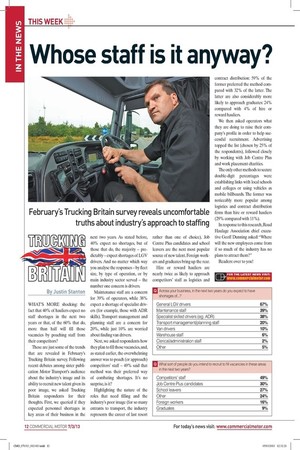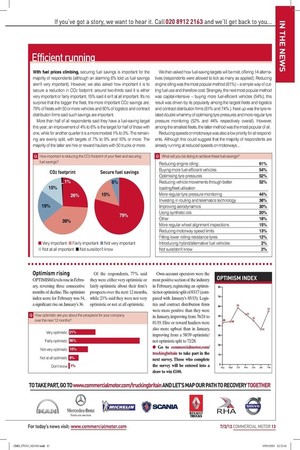Whose staff is it anyway?
Page 8

Page 9

If you've noticed an error in this article please click here to report it so we can fix it.
February's Trucking Britain survey reveals uncomfortable truths about industry's approach to staffing WHAT'S MORE shocking: the fact that 40% of hauliers expect no staff shortages in the next two years or that, of the 60% that do, more than half will fill those vacancies by poaching staff from their competitors?
These are just some of the trends that are revealed in February's Trucking Britain survey. Following recent debates among sister publication Motor Transport's audience about the industry's image and its ability to recruit new talent given its poor image, we asked Trucking Britain respondents for their thoughts. First, we queried if they expected personnel shortages in key areas of their business in the next two years. As stated before, 40% expect no shortages, but of those that do, the majority — predictably — expect shortages of LGV drivers. And no matter which way you analyse the responses — by fleet size, by type of operation, or by main industry sector served — the number one concern is drivers.
Maintenance staff are a concern for 39% of operators, while 38% expect a shortage of specialist drivers (for example, those with ADR skills). Transport management and planning staff are a concern for 20%, while just 10% are worried about finding van drivers.
Next, we asked respondents how they plan to fill those vacancies, and, as stated earlier, the overwhelming answer was to poach (or approach) competitors' staff — 49% said that method was their preferred way of combating shortages. It's no surprise, is it?
Highlighting the nature of the roles that need filling and the industry's poor image (for so many entrants to transport, the industry represents the career of last resort rather than one of choice), Job Centre Plus candidates and school leavers are the next most popular source of new talent. Foreign workers and graduates bring up the rear.
Hire or reward hauliers are nearly twice as likely to approach competitors' staff as logistics and contract distribution: 59% of the former preferred the method compared with 32% of the latter. The latter are also considerably more likely to approach graduates: 24% compared with 4% of hire or reward hauliers.
We then asked operators what they are doing to raise their company's profile in order to help successful recruitment. Advertising topped the list (chosen by 25% of the respondents), followed closely by working with Job Centre Plus and work placement charities.
The only other methods to secure double-digit percentages were establishing links with local schools and colleges or using vehicles as mobile billboards. The former was noticeably more popular among logistics and contract distribution firms than hire or reward hauliers (29% compared with 11%).
In response to this research, Road Haulage Association chief executive Geoff Dunning asked: "Where will the new employees come from if so much of the industry has no plans to attract them?"
Readers: over to you!
Optimism rising OPTIMISM levels rose in February, reversing three consecutive months of decline. The optimism index score for February was 54, a significant rise on January's 36. Of the respondents, 77% said they were either very optimistic or fairly optimistic about their firm's prospects over the next 12 months, while 23% said they were not very optimistic or not at all optimistic. Own-account operators were the most positive section of the industry in February, registering an optimistic/not optimistic split of 83/17 (compared with January's 85/15). Logistics and contract distribution firms were more positive than they were in January, improving from 76/24 to 81/19. Hire or reward hauliers were also more upbeat than in January, improving from a 58/39 optimistic/ not optimistic split to 72/28.
• Go to conunercialmotor.com/ truckingbritain to take part in the next survey. Those who complete the survey will be entered into a draw to win E1110.







































